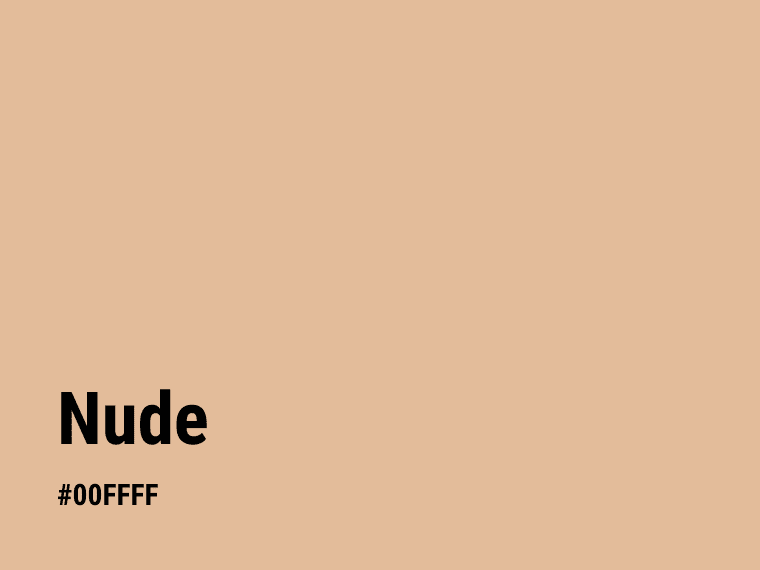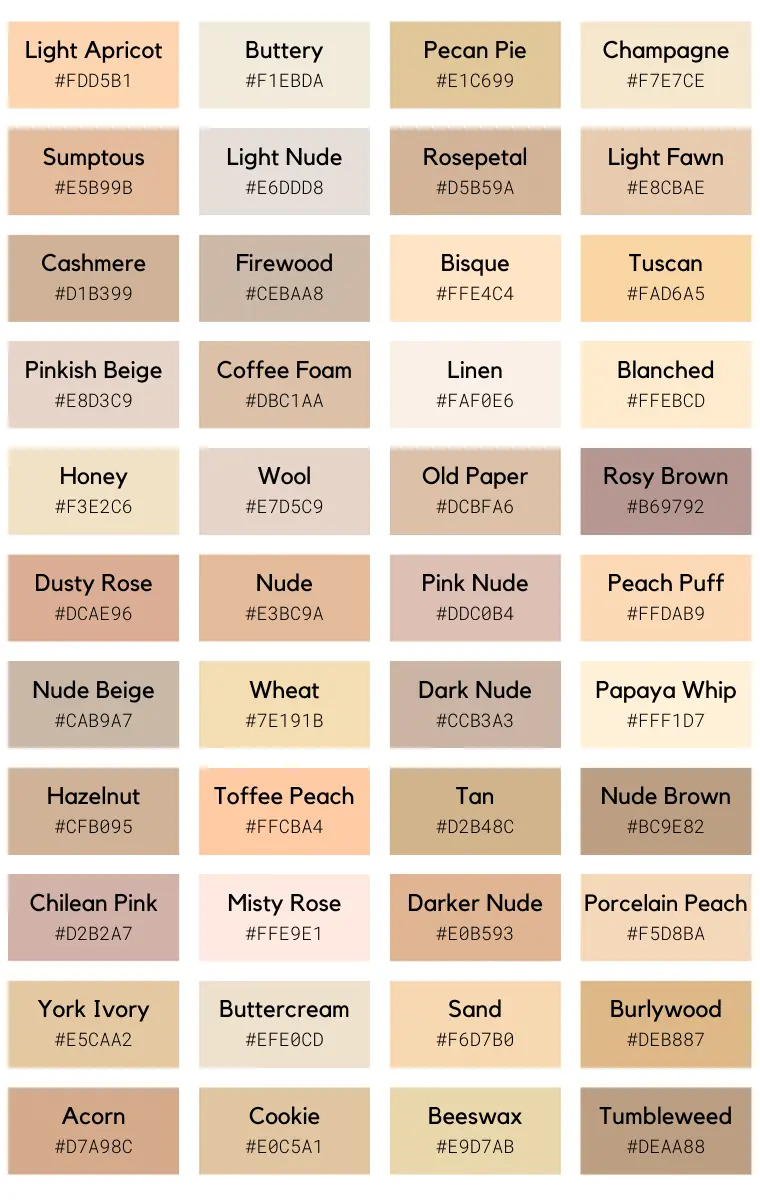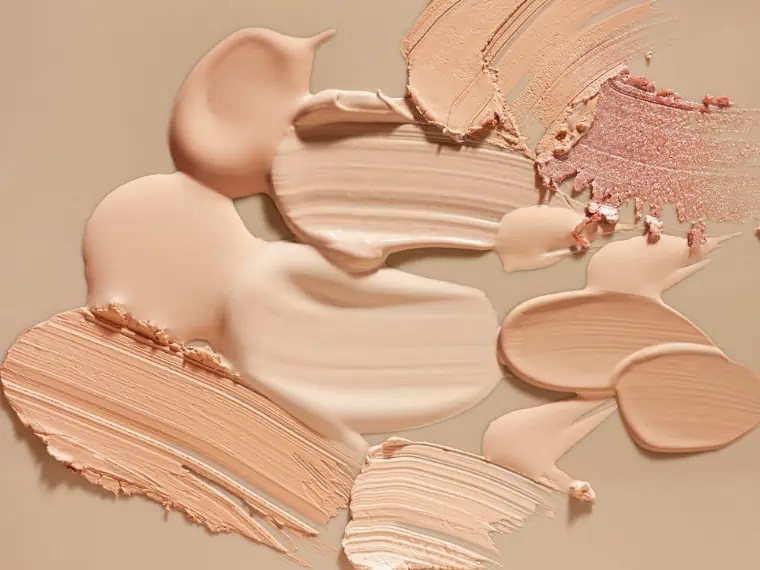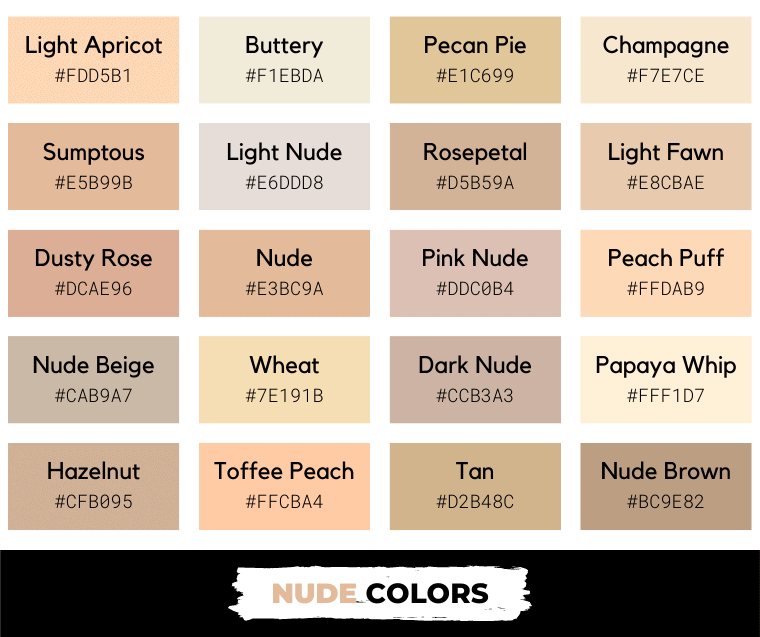Nude color is more than just a color; it is a subtle yet captivating range of shades inspired by human skin tones. Thus, there are many shades of nude color, from brownish-white to peachy-pink, each with a unique charm.
In today’s article, you will learn everything you need to know about the color nude. So we’ll answer questions like:
- What color is nude?
- What are the different shades of nude color?
- What’s the meaning of the color nude?
- What colors pair well with nude?
So, if you’re looking for nude color names and their codes, you’ve come to the right place.
What Color is Nude?

Nude is a pale brownish-white created by mixing brown and white. Its name comes from the light peachy-pink skin tone of the Western-European-centric Caucasian people. Its hex code is #E3BC9A.
Traditionally, we often describe the nude color as a light peachy-pink tone, similar to fair skin color. However, our growing understanding of diversity and inclusivity has broadened the term “nude” to encompass a broader range of skin tones.
So is nude a color?
Today, nude is an umbrella term for various colors resembling different skin tones, from peach to beige.
Peach usually has pink undertones, while beige can come in different variations, from grayish tan to yellowish brown.
Beige vs. Nude
Beige is a light, brownish shade of yellow or grayish-yellow, which often brings to mind the color of unbleached wool.
On the other hand, nude is a pale neutral that comes in many shades that range from beige to peachy pink. Thus, this color refers to a broad spectrum of colors encompassing a wide range of skin tones.
The History of Nude
Underwear was white until the 1910s. Later, a new color called “flesh” hit the market. This color was peachy-pink.
The term “nude” was used to describe women’s underwear in the 1920s.
Later, the term was used to describe a pale pink with yellow undertones, but this was unsuitable for people with different skin tones.
In 2010, Michelle Obama – the first African-American first lady, wore a nude strapless gown that sparked controversy.
The goal of this color was to give a “nude look,” but the creator was limited to a few skin tones.
Unfortunately, the limited vision at the time made it look more like a color than neutral for other darker skin tones.
This controversy prompted well-known brands to expand their range of naked colors. As a result, different shades have emerged to suit all skin tones.
Nude tones have grown in popularity over the last few decades, becoming one of the most popular colors in the fashion and beauty industries.
As a result, the fashion industry has transitioned from pale pinks and beiges to nude colors.
Nude Color Codes
In computer graphics and web design, nude comprises 89% red, 73.7% green, and 60.4% blue. The hex code of nude is #E3BC9A.
When it comes to the printing industry, nude is made up of 17% magenta, 32% yellow, and 11% black.
| Value | CSS | |
|---|---|---|
| Hex | E3BC9A | #e3bc9a |
| RGB | 227, 188, 154 | |
| RGB Percentage | 89, 73.7, 60.4 | rgb(89%, 73.7%, 60.4%) |
| CMYK | 0, 17, 32, 11 | |
| HSV | 27.9°, 32.2, 89 | |
| HSL | 27.9°, 56.6, 74.7 | hsl(27.9°, 56.6%, 74.7%) |
Nude Color Meaning
Nude is the color of different skin tones and natural materials such as wool, jute, hemp, linen, or even brown cotton. It’s a color inspired by nature.
The nude color is soft and delicate, evoking feelings of tranquility and calm.
Moreover, it is a color that resonates with simplicity and modernity. Nude doesn’t like to stand out.
But “nude” refers to various skin tone colors that range from light brownish-whites to peachy-pinks and different beiges.
In terms of color psychology, nude colors are often associated with calmness, peace, and warmth. They are seen as neutral and inviting, and they can also symbolize elegance, simplicity, and sophistication.
In interior design, nude colors are discreet, soothing, and warm. Thus, they are perfect for those who love neutral tones.
Shades of Nude Color
Because this color is derived from skin tone, there are numerous nude color names.
The most popular nude shades include pink nude, pinkish beige, rosy brown, dark nude, rosepetal, peach puff, and bisque.

Nude
This official nude color is described as a light, warm beige or pale tan. It’s actually a mixture of brown and white. The color was named after the Caucasian skin tone of Western European people.
As there are over 110 different skin tones in the world, considerable nude shades have emerged. [1]
Nude
Hex #E3BC9A
RGB 227, 188, 154
CMYK 0, 17, 32, 11
Light Apricot
This is a soft, pastel hue that falls within the orange color family. It’s lighter than nude. However, it’s perceived as a nude color.
Light apricot carries the warmth and vibrancy of oranges and reds but is toned down with a gentle cream.
It is reminiscent of an apricot fruit’s fresh, juicy flesh, hence the name.
Light Apricot
Hex #FDD5B1
RGB 253, 213, 177
CMYK 0, 16, 30, 1
Pink Nude
Pink nude a subtle, muted shade that blends the warmth and softness of pink with the neutral, soothing characteristics of nude colors.
It looks like a more muted peachy pink.
In addition, this color exudes a sense of calm, comfort, and sophistication.
Pink Nude
Hex #DDC0B4
RGB 221, 192, 180
CMYK 0, 13, 19, 13
Hazelnut
Hazelnut is a neutral and comforting color that combines elements of brown and beige, much like the shell of a hazelnut.
It’s a more brownish nude that is still calm and inviting.
Hazelnut
Hex #CFB095
RGB 207,176,149
CMYK 0, 15, 28, 19
Nude Brown
Nude brown is a warm, earthy color that draws on the deeper tones within the nude shades, evoking groundedness and comfort – like any other brown.
Although it looks similar to hazelnut, this is one of the darker nude shades.
Nude Brown
Hex #BC9E82
RGB 188, 158, 130
CMYK 0, 16, 31, 26
Dark Nude
Dark nude is a warm, rich shade of nude that combines the elegance and affection of dusty pink with the simplicity and comfort of beige.
Its depth provides a sense of elegance and sophistication, and its warm undertones convey a sense of comfort and earthiness.
As a darker variation of pink nude, this color is located on the warmer end of the nude color spectrum.
Dark Nude
Hex #CCB3A3
RGB 204, 179, 163
CMYK 0, 12, 20, 20
Almond
Almond is a light, buttery brown shade that brings to mind the delicate, natural shade of almond nuts. Soft and warm, this color features a subtly creamy undertone, blending gentle aspects of beige and brown.
It looks like a more muted and lighter variation of champagne.
Almond
Hex #EADDCA
RGB 234, 221, 202
CMYK 0, 5, 13, 8
Light Nude
Light nude is a very pale, almost off-white color with cream undertones.
Its delicacy makes it an excellent choice for settings that require a neutral backdrop, providing a soothing and airy look.
Light Nude
HEX #E6DDD8
RGB 230, 221, 216
CMYK 0, 4, 6, 10
Beige
Beige is a pale grayish-yellow color that gets its name from the French word for natural wool.
You can perceive it as a pale fawn, a light, sandy, yellowish tan.
However, beige may be an umbrella term for colors ranging from grayish-yellow to yellowish-brown.
Beige
Hex #F5F5DC
RGB 245, 245, 220
CMYK 2, 2, 15, 4
Dessert Sand
Dessert sand is a warm, light to medium brown with red undertones that embodies the peachy-brown hue of desert sand dunes – hence the name.
It looks similar to light apricot but is more muted due to the black in the composition.
Its natural, earthy qualities make it a delightful choice for both interior design and fashion.
Desert Sand
Hex #EDC9AF
RGB 237, 201, 175
CMYK 0, 15, 26, 7
Champagne
Champagne is a nude color created from a mixture of pale yellow and orange. The name of this yellowish-orange color comes from the famous sparkling wine, originally produced in the region of the same name in France.
This color evokes elegance, celebration, luxury, and light-heartedness.
However, champagne comes in many hues that range from light gold to pale yellow.
Champagne
Hex #F7E7CE
RGB 247, 231, 206
CMYK 2, 6, 16, 0
Pecan Pie
Pecan pie is a light shade of tan, which is known as a pale brown. It’s slightly darker than wheat. This hue captures a freshly baked pecan pie’s rich, sweet, and cozy essence, exuding a sense of comfort and delight.
Moreover, it provides earthiness and warmth, making it a good choice as an inviting nude shade.
Pecan Pie
Hex #E1C699
RGB 225, 198 153
CMYK 0, 12, 32, 12
Tan
The color tan is a pale, light brown that is often associated with the color of tanned leather or skin. Its name comes from the Middle English word “tannen,” which means “to convert into leather.”
Unlike nude, which is a light pinkish-beige, tan is a soft, muted brown without any pink undertones. However, the shade is situated between nude and nude brown.
Tan
Hex #D2B48C
RGB 210, 180, 140
CMYK 13, 28, 50, 18
Cookie Dough
Cookie dough is a warm, light to medium brown color, similar to some skin tones. Therefore, it could be included in the spectrum of nude shades.
Moreover, it has a slightly yellow or beige tint, similar to the color of raw cookie dough before it’s baked.
Cookie Dough
Hex #CDB79E
RGB 205, 183, 158
CMYK 9, 19, 36, 20
Dusty Rose
Dusty rose is a muted shade of pink with a slight tinge of brown, giving it a subdued, almost vintage look.
It resembles the color of some varieties of dried or faded roses, hence the name.
This soft dusty pink evokes romance and elegance.
Dusty Rose
Hex #DCAE96
RGB 220, 174, 150
CMYK 0, 21, 32, 14
Mocha
Mocha is a medium brown resembling a drink made with steamed milk, espresso and cocoa powder.
Its name is derived from the rich, dark color of mocha coffee, a coffee type initially shipped from the port of Mocha in Yemen.
Mocha
Hex #BEA493
RGB 190, 164, 147
CMYK 0, 14, 23, 25
Nude Beige
Nude beige is a soft and neutral color, somewhat similar to the color of a lightly roasted almond.
It’s also a shade of nude that evokes sophistication and naturalness.
Moreover, its beige side evokes calmness and warmth.
Nude Beige
Hex #CAB9A7
RGB 202, 185, 167
CMYK 0, 8, 17, 21
Light Fawn
Light fawn is a pale, warm, yellow-tinted brown. Fawn refers to a light, yellowish-brown color, much like the coat of a young deer, which is where the name originates.
So, it’s a pale yellowish-tan color.
Light Fawn
Hex #E8CBAE
RGB 232, 203, 174
CMYK 0, 13, 25, 9
Toffee Peach
Toffee peach is a light shade of orange that combines the caramel-like color of toffee and a peach’s soft, warm hue.
Thus, it combines the vitality and playfulness of peach with the optimism and enthusiasm of orange.
It’s a great color to create a light, airy, and comfortable atmosphere.
Toffee Peach
Hex #FFCBA4
RGB 255, 203, 164
CMYK 0, 20, 36, 0
Sumptuous Peach
This is a warm, muted shade of peach with brownish undertones created by mixing dusty pink and peach. Thus, it’s a darker shade of nude.
Sumptuous Peach
Hex #E5B99B
RGB 229, 185, 155
CMYK 0, 19, 32, 10
Peach Puff
Peach puff is a pale orange resembling the soft color of a ripe peach. It’s lighter than toffee peach and light apricot.
Peach Puff
Hex #FFDAB9
RGB 255, 218, 185
CMYK 0, 15, 27, 0
Vanilla Custard
Vanilla custard is a light, creamy, yellowish color. It’s warm, soft, and slightly muted, much like the color of a vanilla custard dessert.
This nude shade resembles a lot of the color of wheat.
Vanilla Custard
Hex #F3D9A9
RGB 243, 217, 169
CMYK 5, 12, 38, 0
Papaya Whip
Papaya whip is a light peach with pink undertones. It’s a mixture of orange, yellow, and pink with a lot of white.
That’s why this pastel orange or peach has a creamy appearance.
However, this light nude color is paler than the succulent flesh of a ripe papaya.
Papaya Whip
Hex #FFF1D7
RGB 255, 241, 215
CMYK 0, 5, 16, 0
Wheat
Wheat is a light, warm beige that features the warm, golden-brown hues of harvested wheat grain.
This combination of soft yellow and light brown tones evokes a sense of warmth and simplicity, reminiscent of the humble yet essential grain after which it is named.
Wheat
Hex #F5DEB3
RGB 245, 222, 179
CMYK 6, 8, 31, 0
Rosepetal
Rosepetal is a gentle, muted pink with a slight touch of brown, reminiscent of a delicate, slightly dried rose petal. It’s similar to dusty rose but tends to be slightly lighter and warmer.
Compared to the traditional nude tone, this is a dark nude color.
Rosepetal
Hex #D5B59A
RGB 213, 181, 154
CMYK 0, 15, 28, 17
Butterybrown
This nude color is a pale grayish-yellow that combines cream and light brown. It has the earthiness of brown but the brightness and softness associated with cream.
Buttery Brown
Hex #F1EBDA
RGB 241, 235, 218
CMYK 0, 2, 10, 5
Cashmere
Cashmere is a pale sandy fawn that looks like a creamy brown. Moreover, this color brings to mind the soft, luxurious fabric it’s named after, known for its comfort and sophistication.
In addition, it evokes an image of natural wool, offering a sense of comfort, warmth, and organic richness.
Cashmere
Hex #D1B399
RGB 209, 179, 153
CMYK 0, 14, 27, 18
Firewood
Firewood is a light brown with red undertones, resembling dried wood. It’s cozy and warm as the natural, earthy cut and dried wood tones.
As a result, it’s a shade of nude that combines brown and beige.
Firewood
Hex #CEBAA8
RGB 206, 186, 168
CMYK 0, 10, 18, 19
Different Nude Colors
Bisque
Hex #FFE4C4
RGB 255, 228, 196
CMYK 0, 11, 23, 0
Tuscan
Hex #FAD6A5
RGB 250, 214, 165
CMYK 0, 14, 34, 2
Pinkish Beige
Hex #E8D3C9
RGB 232, 211, 201
CMYK 0, 9, 13, 9
Coffee Foam
Hex #DBC1AA
RGB 219, 193, 170
CMYK 0, 12, 22, 14
Linen
Hex #FAF0E6
RGB 250, 240, 230
CMYK 0, 4, 8, 2
Blanched Almond
Hex #FFEBCD
RGB 255, 235, 205
CMYK 0, 8, 20, 0
Honey
Hex #F3E2C6
RGB 243, 226, 198
CMYK 0, 7, 19, 5
Wool
Hex #E7D5C9
RGB 231, 213, 201
CMYK 0, 8, 13, 9
Old Paper
Hex #DCBFA6
RGB 220, 191, 166
CMYK 0, 13, 25, 14
Rosy Brown
Hex #B69792
RGB 182, 151, 146
CMYK 0, 17, 20, 29
Chilean Pink
Hex #D2B2A7
RGB 210, 178, 167
CMYK 0, 15, 20, 18
Misty Rose
Hex #FFE9E1
RGB 255, 233, 225
CMYK 0, 9, 12, 0
Darker Nude
Hex #E0B593
RGB 224, 181, 147
CMYK 0, 19, 34, 12
Porcelain Peach
Hex #F5D8BA
RGB 245, 216, 186
CMYK 0, 12, 24, 4
Buttercream
Hex #EFE0CD
RGB 239, 224, 205
CMYK 0, 6, 14, 6
York Ivory
Hex #E5CAA2
RGB 229, 202, 162
CMYK 0, 12, 29, 10
Sand
Hex #F6D7B0
RGB 246, 215, 176
CMYK 0, 13, 28, 4
Burlywood
Hex #DEB887
RGB 222, 184, 135
CMYK 0, 17, 39, 13
Tumbleweed
Hex #DEAA88
RGB 222, 170, 136
CMYK 0, 23, 39, 13
Acorn
Hex #D7A98C
RGB 215, 169, 140
CMYK 0, 21, 35, 16
Beeswax
Hex #E9D7AB
RGB 233, 215, 171
CMYK 0, 8, 27, 9
Birdseed
Hex #E2C28E
RGB 226, 194, 142
CMYK 0, 14, 37, 11
Fortune Cookie
Hex #E0C5A1
RGB 224, 197, 161
CMYK 0, 12, 28, 12
Golden Fog
Hex #F0EAD2
RGB 240, 234, 210
CMYK 0, 3, 13, 6
Mojave Desert
Hex #C7B595
RGB 199, 181, 149
CMYK 0, 9, 25, 22
Latte
Hex #C5A582
RGB 197, 165, 130
CMYK 0, 16, 34, 23
Light Taupe
Hex #B38B6D
RGB 179, 139, 109
CMYK 0, 22, 39, 30
Light Copper
Hex #F6CBA0
RGB 246, 203, 160
CMYK 0, 17, 35, 4
Peach Orange
Hex #FFCC99
RGB 255, 204, 153
CMYK 0, 20, 40, 0
Apricot Orange
Hex #FBCEB1
RGB 251, 206, 177
CMYK 0, 18, 29, 2
Pastel Orange
Hex #FED8B1
RGB 254, 216, 177
CMYK 0, 15, 30, 0
What Colors Go with Nude?
Nude colours are increasingly popular in fashion and interior design because they are associated with simplicity, tranquility and relaxation.
When it comes to interior design, they are not overpowering, complementing any style from rustic to modern.
Whether for fashion or interior design, nude colors go well with pure neutrals (black, snow white, brown, beige) and bright, saturated hues such as emerald, burgundy, crimson, red, orange, and yellow.
Moreover, they pair well with gentle pastels such as cream, light pink, lavender, soft peach, or pale mint.
How to Wear the Nude Colors

Wearing nude create a chic, timeless, and versatile look by providing sophistication, feminity, and charm.
They feature warm undertones associated with warmth and comfort.
In order to highlight nude shades, it’s best to wear them with a contrasting color. That prevents a bland look.
They also go great when you match them with your hair or eye color.
Nude colors can have a slimming effect, especially when worn in a monochromatic outfit. If you aim for this, consider wearing nude colors from head to toe.
In the fashion industry, you can wear nude as manicures, makeup, shoes, clothing (blouse, skirt, suit), and accessories.
Here are some helpful steps on how to wear nude shades.
Find Your Nude Color
The first step is to find the right shade for your skin tone. Nudes range from pale beige to deep brown.
A “nude” color should ideally be a shade that complements your skin tone.
It doesn’t necessarily need to match your skin tone exactly; it can be slightly darker or lighter, depending on the look you’re going for.
Provide Contrast
Pairing a nude color with a contrasting color can make your outfit pop. For example, a nude top could be worn with dark jeans for a chic, casual look.
Alternatively, a nude-colored dress could be paired with brightly colored accessories to add a splash of color.
Layer Different Shades of Nude
Don’t be afraid to wear different nude shades together. This can create a sophisticated, monochromatic look.
Try layering different shades and textures to add depth to your outfit.
Accessorize
Nude accessories like shoes and bags can work with almost any outfit.
Nude shoes, in particular, can elongate the legs when they closely match your skin tone.
Highlight with Makeup
When wearing nude colors, your makeup can provide a beautiful contrast.
Bold lip colors or smokey eyes can stand out beautifully against a nude outfit.
Last Words on Nude Colors
So, what are nude colors? Nude colors refer to different shades ranging from beige and light brownish colors to soft tones of peach and peachy pink. They resemble natural skin color.
Since skin tones differ, nude colors come in many variations.
However, this gamut of colors is associated with neutrality, modesty, elegance, simplicity, and warmth.
Did you enjoy this article about shades of nude? Share it with your friends who love these soft tones.

